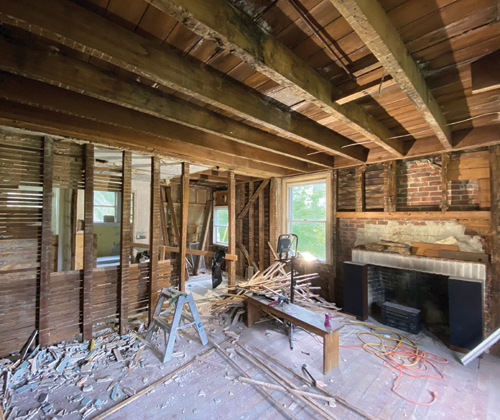Grants keep Oviatt House restoration moving forward
by Sheldon Ocker
How far can $50,000 go toward renovating a home? In the case of the Oviatt House, all the way back to the mid-19th century when Richfield was a prime stop on the Underground Railroad.
Saving the Oviatt House has been the mission of Judy Bowman and many other Richfield residents, including her husband Ken, a restoration carpenter with the Cuyahoga Valley National Park, and his friend from high school, Larry Brichacek, also an expert in bringing back archaic structures from the dead.
Judy Bowman is president of Oviatt House Inc., a non-profit formed to reclaim the house, and Ken Wood and Bob Hooper are officers. Bowman thinks it will cost about $200,000, a relatively modest amount, thanks to a group of 15 or more volunteers.
“I can’t imagine how much we already saved by having over 700 hours of volunteer work,’’ she said. “It probably would cost twice as much.’’
It was a struggle to convince the Richfield Joint Recreation District board to undo their action in condemning the old house. In November 2019, the board voted 6-1 to raze the structure after being told it was too far gone to save. But Ken Bowman and Brichacek enlightened the board after examining the structure, insisting the naysayers were wrong, and the board rescinded its decision.
Then it became a question of financing the project. So far, Oviatt House Inc. has succeeded in procuring more than half the cash needed to restore the house. According to Judy Bowman, in addition to a $50,000 newly-awarded grant from the Ohio Capital Budget, the organization has “raised over $65,000 – that’s money in hand – and we’re still expecting to get from pledges at least $10,000 more this year.’’
Bowman’s group has applied for more grants, including $10,000 from the Akron Community Foundation for general-purpose use.
“We won’t have an answer on some of these until this fall,’’ Bowman said. “We’ve had a great start. We have over half of the money.’’
Bowman learned early in August that the group had won a $3,528 grant from the National Underground Railroad Network to Freedom organization. The cash will be used to build and install custom window sashes on the house.
The $50,000 Ohio Capital Budget grant will be used immediately.
“This will enable us to work on the interior, which we didn’t think we’d be able to do for awhile,’’ said Bowman, who added that volunteers have gutted the inside of the house.
In peeling off the various layers of the interior of the 1836 house, certain original elements were still intact.
“It was interesting to remove all the walls,’’ Bowman said. “We could tell the upstairs walls were original because they were accordion lath, not the later type called split lath. The first floor was a little trickier. We thought some of the walls were original, but they were just very old.’’
By removing all the walls, the group was able to determine the original layout of the house.
The first exterior element to be replaced is the roof.
“We’ve hired a contractor to put on wood shingles,” Bowman said. “We [originally] didn’t know if it would be wood, metal or slate, the options during that period. ‘’
But Ken Bowman walked the roof and found wood shingles. They probably were not the original shingles but replacements that have been there for a long while. In addition, there was a sawmill on the property, leading to the conclusion that the original roof was wooden.
Mason Oviatt built the house 186 years ago, making it one of the oldest residences in Richfield. But there is more significance to the structure than its age. Oviatt abetted the work of abolitionist John Brown – who lived for a time in Richfield, Hudson and Akron – whose obsession was helping runaway slaves reach safety in Canada.
Documentation shows that Oviatt was a conductor on the Underground Railroad, transporting freedom-seeking slaves to their next stop, usually Oberlin.
When the restoration is complete, Oviatt House Inc. has plans to turn the building into a museum. On Saturday, Sept. 24, they will open the house for tours from noon-4 p.m.
“In our contract with the RJRD, we can open it up as an educational museum, and that’s our intent,’’ Judy Bowman said. “It would focus on abolitionist activities in Richfield and the history of the Western Reserve.’’
Oviatt House Inc. is responsible for maintaining the house for 10 years. Toward that end, the group will set aside $5,000 annually. The contract will renew automatically unless either the RJRD or Oviatt House Inc. decides to cancel it.
Bowman hopes that work on the house is finished by the end of 2023 and that landscaping can be done in 2024.
“It all depends on fundraising,’’ she said.
Contributions can be made on the group’s web site, oviatthouse1836.com. ∞
Photo: The original fireplace and hand hewn lathe on the first floor of the 1836 Oviatt House are now exposed and can be repaired as needed. Photo by S. Serdinak.

